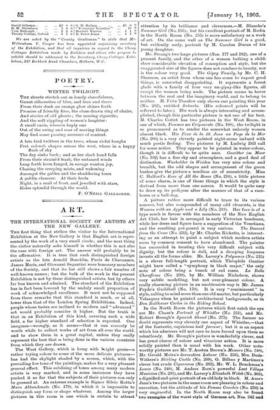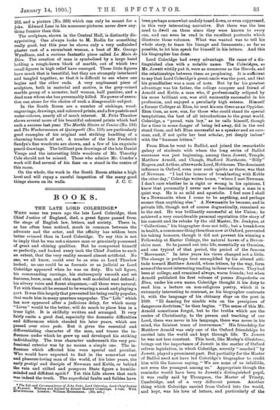THE first thing that strikes the visitor to the International
Exhibition at the New Gallery is that English art is repre- sented by the work of a very small circle ; and the next thing the visitor naturally asks himself is whether this is not also the case with foreign art. The answer will probably be in the affirmative. It is true that such distinguished foreign artists as the late Arnold Boecklin, Puvis de Chavannes, James Maris, and Giovanni Segantini were honorary members of the Society, and that its list still shows a fair number of well-known names ; but the bulk of the work in the present Exhibition is not by these distinguished artists, but by others far less known and admired. The standard of the Exhibition has in fact been lowered by the unduly small proportion of work of acknowledged excellence. It must not be supposed from these remarks that this standard is much, or at all, lower than that of the London Spring Exhibitions. Indeed, people whose tastes are inclined to modern and " advanced " art would probably consider it higher. But the truth is that in an Exhibition of this kind, covering such a wide field, a far higher standard of selection is expected. One imagines—wrongly, as it seems—that it can scarcely be worth while to collect works of art from all over the world, and to show them in a great capital, unless they really represent the best that is being done in the various countries from which they are drawn.
The West Gallery, which is bung with fright green—a rather trying colour to some of the more delicate pictures— has had the skylight shaded by a screen, which, with the prevailing low tone of the paintings, makes for a very pleasant general effect. This subduing of tones among many modern artists is very marked, and in some instances they have pushed it so far that the subjects of their pictures can only be guessed at. An extreme example is Signor Silvio Rotta's Mura Abband,onate (No. 179), in which it is impossible to distinguish any form or shape whatever. Among the larger pictures in this room is one which is certain to attract in the North Room (No. 255) is more satisfactory as a work of art. On the same wall as The Summer Girl is a good,
but evidently early, portrait by M. Carolus Duran of his young daughter. • Mr. Strang's two large pictures (Nos. 177 and 182), one of a peasant family, and the other of a woman bathing a child, show considerable elevation of conception and style, but the
exaggerated size of the figures does not conduce to beauty, nor is the colour very good. The Gipsy Family, by Mr. C. H.
Shannon, an artist from whom one has come to expect good things, is somewhat disappointing. It represents a forest glade with a family of four very un-gipsy-like figures, all except the woman being nude. The picture seems to hover between the real and the imaginary world, and to belong to neither. M. Fritz Thaulow only shows one painting this year
(No. 202), entitled Suburbs. (His coloured prints will be
referred to later.) His work is always interesting and accom- plished, though this particular picture is not one of his best.
M. Charles Cottet has two pictures in the West Room, in
one of which, Femmes an Crgpuscule (No. 198), the twilight is so pronounced as to render the somewhat unlovely women almost black. His Feux de la St. Jean an Pays de lee Mer
(No. 206) is a very cleverly painted night-scene imbued with much poetic feeling. Two pictures by M. Ludwig Dill call
for some notice. They appear to be painted in water-colour, though it is difficult to be quite sure. Gewitter im Moor (No. 192) has a fine sky and atmosphere, and a good deal of distinction. Wo,cholder in Weiden has very nice colour and breadth, but the odd shapes and arrangement of the green bushes give the picture a needless air of eccentricity. Miss C. Halford's Rose of All the Roses (No. 210), a little picture of some charm, is one of those things in which the style is derived from more than one source. It would be quite easy to draw up its pedigree after the manner of that of a race- horse or a bull-dog.
A picture rather more difficult to trace to its various sources, but also compounded of many odd elements, is the Woman with an Apple and a Lily (No. 218). Her face is of a type much in favour with the members of the New English Art Club, her hair is arranged in early Victorian bandeaux, while her dress and figure have a suggestion of the Venetians, and the resulting pot-pourri is very curious. The Descent from the Cross (No. 232), by Mr. Charles Ricketts, is interest- ing as an attempt to paint a subject which modern artists seem by common consent to have abandoned. The painter . has succeeded in treating this very difficult subject with dignity, but the colour is dull, and a drooping limpness invests all the forms alike. Mr. Lavery's Polymnia (No. 235) is a clever full-length portrait, which Theopbile Gautier might have called a "symphony in black major," the only note of colour being a bunch of red roses. La Belle Chauffeuse (No. 239), by Mr. William Nicholson, shows very subtle modelling, but not over-pleasant colour. A really charming picture in an unobtrusive way is Mr. James Pryde's Guildhall (No. 170). It is very " reminiscent " in style, calling to mind more than one old master, but particularly Velasquez when he painted architectural backgrounds, as in Don Balthazar Carlos in the Biding School.
In the North Room the pictures which first catch the eye are Mr. Chase's Portrait of Whistler (No. 251), and Mr. Robert Brough's Spanish Shawl (No. 275). The former no doubt represents very cleverly one aspect of Whistler,—that of the fantastic, capricious half farceur; but it is an aspect which his admirers will not care to have forced upon them so relentlessly. Mr. Brough's picture is wonderfully clever, and has great charm of colour and vivacious action. It is more solidly painted than is usual with his work. Other note- worthy pictures are Mr. T. Austen Brown's Mowers (No. 248), Mr. Gerald Moira's decorative Labour (No. 256), Mrs. Dods- Withers's Stirling Castle (No. 269), G. Bilbao y Martinez's clever but crude Cigarreros (No. 282), Mr. W. L. Bruckman's Lewes (No. 248), M. Anders Zorn's powerful Last Village Musician (No. 295), and Mr. Lavery's Elizabeth Welsh (No. 308), a dignified and quiet portrait of an old lady in black. M. Amman Jean's two pictures in the same room are pleasing in colour and execution, but the attitude of his Femme Couchie (No. 250) is very ungraceful. In the North Room may also be found two =unplug of the worst style of German art, Nos. 242 and Herbert Warren ... ... 1 1 0 Summer Girl (No. 195); but his excellent portrait of M. Rodin The sculpture, shown in the Central Hall, is distinctly dis- appointing. One always looks to M. Rodin for something really good, but this year he shows only a very unfinished plaster cast of a recumbent woman, a bust of Mr. George Wyndham, and a curious fantastic piece called La Main de Dieu. The creation of man is symbolised by a large hand holding a rough-hewn block of marble, out of which two small figures in high relief have emerged. These little figures have much that is beautiful, but they are strangely interlaced and tangled together, so that it is difficult to see where one begins and the other ends. A very unpleasant piece of sculpture, both in material and motive, is the grey-veined marble group of a monster, half woman, half panther, and a dead man whom she has presumably killed. No power of execu- tion can atone for the choice of such a disagreeable subject.
In the South Room are a number of etchings, wood- engravings, drawings, and coloured prints, and afew pastels and water-colours, nearly all of much interest. M. Fritz Thaulow shows several more of his beautiful coloured prints which bad such a success last year. The Marble Stairs at Venice (No. 118) and The Washerwomen at Quimperle (No. 119) are particularly good examples of his original and striking handling of a charming branch of art. A number of the late Frederick Sandys's fine woodcuts are shown, and a few of his exquisite pencil drawings. The brilliant pen drawings of the late Daniel Vierge and the interesting little woodcuts of Mr. Timothy Cole should not be missed. Those who admire Mr. Conder's work will find several of his fans on a stand in the centre of this room.
On the whole, the work in the South Room attains a high level and will repay a careful inspection of the many good
things shown on its walls. J. C. C.







































 Previous page
Previous page